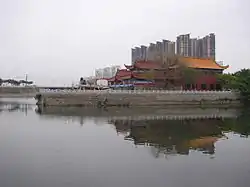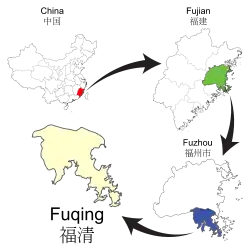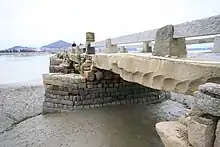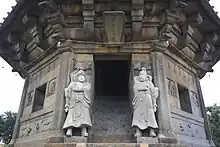Fuqing
ⓘ (Chinese: 福清; pinyin: Fúqīng; Wade–Giles: Fu2-ch'ing1; Pe̍h-ōe-jī: Hok-chhiaⁿ; Foochow Romanized: Hók-chiăng; also romanized as Hokchia) is a county-level city of Fujian Province, China, it is under the administration of the prefecture-level city of Fuzhou.
Fuqing
福清市 Futsing | |
|---|---|
 On the Longjiang River in Downtown Fuqing | |
 Location of Fuqing City within Fuzhou City | |
 Fuqing Location of the city centre in Fujian | |
| Coordinates: 25°43′N 119°23′E | |
| Country | People's Republic of China |
| Province | Fujian |
| Prefecture-level city | Fuzhou |
| Population (2018) | |
| • Total | 1,381,000[1] |
| Time zone | UTC+8 (CST) |
| GDP (nominal) | 2018 |
| - Total | ¥110.21 billion ($16 billion) |
| – Per capita | ¥84,105 ($12,709) |
| – Growth | |
| Website | www |
Geography

Fuqing is located in the north-central part of Fujian's sea coast, south of Fuzhou and north of Putian. It has a long indented coast line on the Taiwan Strait, to the south of Fuzhou.
The northern part of the county-level city, including the city's central urban area, is in the valley of the Longjiang River. The southern part includes a number of peninsulas with highly indented coast.
Climate
| Climate data for Fuqing (1991–2020 normals, extremes 1981–2010) | |||||||||||||
|---|---|---|---|---|---|---|---|---|---|---|---|---|---|
| Month | Jan | Feb | Mar | Apr | May | Jun | Jul | Aug | Sep | Oct | Nov | Dec | Year |
| Record high °C (°F) | 27.0 (80.6) |
29.3 (84.7) |
29.7 (85.5) |
31.2 (88.2) |
33.0 (91.4) |
35.1 (95.2) |
36.4 (97.5) |
37.2 (99.0) |
37.1 (98.8) |
33.7 (92.7) |
30.8 (87.4) |
27.6 (81.7) |
37.2 (99.0) |
| Average high °C (°F) | 15.3 (59.5) |
15.8 (60.4) |
18.4 (65.1) |
22.9 (73.2) |
26.7 (80.1) |
29.8 (85.6) |
32.6 (90.7) |
32.4 (90.3) |
30.2 (86.4) |
26.1 (79.0) |
22.1 (71.8) |
17.5 (63.5) |
24.2 (75.5) |
| Daily mean °C (°F) | 11.7 (53.1) |
12.0 (53.6) |
14.3 (57.7) |
18.8 (65.8) |
23.0 (73.4) |
26.4 (79.5) |
28.9 (84.0) |
28.6 (83.5) |
26.7 (80.1) |
22.8 (73.0) |
18.9 (66.0) |
14.1 (57.4) |
20.5 (68.9) |
| Average low °C (°F) | 9.4 (48.9) |
9.5 (49.1) |
11.6 (52.9) |
15.9 (60.6) |
20.3 (68.5) |
24.1 (75.4) |
26.2 (79.2) |
26.0 (78.8) |
24.2 (75.6) |
20.4 (68.7) |
16.6 (61.9) |
11.7 (53.1) |
18.0 (64.4) |
| Record low °C (°F) | 0.5 (32.9) |
1.3 (34.3) |
0.3 (32.5) |
6.7 (44.1) |
11.0 (51.8) |
15.9 (60.6) |
20.5 (68.9) |
21.5 (70.7) |
16.0 (60.8) |
10.9 (51.6) |
6.2 (43.2) |
−0.3 (31.5) |
−0.3 (31.5) |
| Average precipitation mm (inches) | 47.0 (1.85) |
75.9 (2.99) |
113.2 (4.46) |
126.4 (4.98) |
169.4 (6.67) |
296.8 (11.69) |
177.2 (6.98) |
252.7 (9.95) |
157.7 (6.21) |
53.5 (2.11) |
41.7 (1.64) |
37.8 (1.49) |
1,549.3 (61.02) |
| Average precipitation days (≥ 0.1 mm) | 7.8 | 10.9 | 15.1 | 14.3 | 16.0 | 15.5 | 10.3 | 13.0 | 11.5 | 6.5 | 7.0 | 7.2 | 135.1 |
| Average snowy days | 0.1 | 0.1 | 0 | 0 | 0 | 0 | 0 | 0 | 0 | 0 | 0 | 0 | 0.2 |
| Average relative humidity (%) | 71 | 74 | 75 | 76 | 78 | 81 | 77 | 77 | 74 | 69 | 70 | 68 | 74 |
| Mean monthly sunshine hours | 103.2 | 91.0 | 103.2 | 117.8 | 127.1 | 143.6 | 233.3 | 208.9 | 170.7 | 159.0 | 115.2 | 113.9 | 1,686.9 |
| Percent possible sunshine | 31 | 29 | 28 | 31 | 31 | 35 | 56 | 52 | 47 | 45 | 36 | 35 | 38 |
| Source: China Meteorological Administration[2][3] | |||||||||||||
Administrative division
- Yuping Subdistrict (玉屏街道) - city center, and location of the city government
- Longshan Subdistrict (龙山街道)
- Longjiang Subdistrict (龙江街道)
- Yinxi Subdistrict (音西街道) - western part of the main urban area
- Honglu Subdistrict (宏路街道)
- Shizhu Subdistrict (石竹街道)
- Yangxia Subdistrict (阳下街道)
- Haikou (海口镇),
- Chengtou (城头镇),
- Nanling (南岭镇),
- Longtian (龙田镇),
- Jiangjing (江镜镇),
- Gangtou (港头镇),
- Gaoshan (高山镇),
- Shabu (沙埔镇),
- Sanshan (三山镇),
- Donghan (东瀚镇),
- Yuxi (Yuki) (渔溪镇),
- Shangjing (上迳镇),
- Xincuo (新厝镇),
- Jiangyin (江阴镇),
- Dongzhang (东张镇),
- Jingyang (镜洋镇),
- Yidu (一都镇)
Economy
As of 2022, Fuqing's Nominal GDP was US$24.6 billion (CN¥160 billion), ranked 4th among county-level administrative units in Fujian province; its Nominal GDP per capita was US$17,702 (CN¥115,067).
Industries that contribute to GDP for 2017:
| Industry | GDP percentage |
|---|---|
| IT manufacturing (Monitor, TV, and related) | 20.4% |
| Food processing (Grilled Eel, Seafood etc) | 13.4% |
| Pipe and Conduit material | 8.5% |
| Chemical materials | 7.9% |
| Power plant | 4.3% |
| Auto & construction Glass | 3.4% |
| Textile | 3.2% |
| Medicine manufacturing | 1.6% |
| Retail & others | 34.6% |
Total GDP:
| YEAR | GDP Amount |
|---|---|
| 2022 | 160B CNY (about 24.6 billion in USD) [4] |
| 2021 | 141.4B CNY (about 21.7 billion in USD) |
| 2020 | 122.854B CNY (about 18.9 billion in USD) |
| 2019 | 115B CNY (about 17.6 billion in USD) |
| 2018 | 110.21B CNY (about $16 billion in USD)[5] |
| 2017 | 99.661B CNY |
| 2016 | 85.921B CNY |
Overseas Fuqing
Fuqing, as well as most of the rest of Fujian, is known for its large number of emigrants, or huaqiao. The first wave of emigration[6][7] started in 1940s; most common destinations during that time were Indonesia, Singapore, and East Malaysia. Some became among the richest men in Southeast Asia, e.g. Sudono Salim (Salim Group), Hendra Rahardja, Rachman Halim (Gudang Garam), Henry Kwee Hian Liong (Pontiac Land Group).
Overseas Fuqingese assembled into associations for mutual support, including the International Association of Fuqing, Perkumpulan Fuqing (Indonesia), and Singapore Futsing Association.
Local dialect

Fuqing has its own dialect which is closely related to the Fuzhou dialect, although the two are mutually intelligible to quite a high extent. Since it is a hilly area where mountains used to isolate each village, there are many variations in the local dialects. Most of its people can also speak Mandarin, which is used in schools, businesses, and to communicate with people from different parts of the province. Songs sung in Fuqing dialect are available online.
Regional foods
Fuqing is located in the coastal hills, subtropical climate, warm and rainy, but the river is short and shallow. Rich in species while not rich in harvest. Therefore, the important staple food in Fuqing is sweet potato. Non-staple food is dominated by various marine food. Many traditional snacks are made from sweet potato and seafood.[8]

Guangbing (光饼): Guangbing is a bread product that is baked and shaped like a sesame-seeded burger bun top. In 1562, the Japanese invaded Fujian province. General Qi Jiguang was charged to drive the invaders out of Fujian. In order not to let the meal time slow down their marching speed, General Qi invented a kind of bread which was shaped into a ring at that time, so his soldiers could wear a string of those breads around their neck. After the victory, the recipe of this bread product was spread throughout the province and named Guangbing after General Qi. Nowadays, there is no longer a hole in the center of a Guangbing, and there are various kinds of Guangbing developed in different areas in Fujian province, which don’t look the same. Fuqing Guangbing is made of the flour, sugar and salt which are all locally produced, as well as the excellent Fuqing sesame seeds, which are very big and taste better than ordinary small sesame seeds. Guangbing was handed down by people to commemorate Qi Jiguang's achievements, which has been used and developed to this day. The people of Fuqing not only passed down the making method of Guangbing, but also passed down the culture to make ritual offerings, Guangbing, to their ancestors.
Oyster Patties (海蛎饼): Oyster patties are a fried snack made of rice flour (pulp), soya bean powder (pulp), oyster, pork, cabbage and seaweed.[9]
Fish Ball (鱼丸): Fuqing fish balls are balls of fish mince made from eels, mackerel or freshwater fish, and sweet potato flour mixed evenly to make its wrappers. Inside, they contain the mince of pork or shrimp.[9]
Sweet Potato Ball (番薯丸): Sweet potato balls have a wrapper made of starch and sweet potato flour. The mince is made of oyster, seaweed and pork. Sweet potato balls represent family reunion.
Seaweed Cake (紫菜饼): Seaweed cakes are made of flour and seaweed, traditionally using a stone oven.
Festival and special customs
Fuqing has some special customs different from other areas in China, which reflects the local history and culture. Fuqing customs have four obvious influences:
(1) the legacy of ancient Yue; (2) ancient Central Plains culture; (3) religion, especially Buddhism and Taoism; (4) in modern times, foreign culture
Spring Festival
Unlike other areas of China, the top part of the couplets traditionally put up during the Chinese New Year are white, not red. It is said that in 1562 on New Year's Eve, when the Japanese invaded Fuqing, people had to escape shortly after putting up the Spring Festival couplets. Upon returning after General Qi Jiguang's victory, people changed the couplets from red, which represents joy and celebration, into green or added white on the top to mourn for their family and friends who had died in the conflict.[10]
On the first day of the new year, people in Fuqing eat Xianmian, an extra-thin noodle with two duck eggs to represent longevity. In the local language, the pronunciation of duck egg is similar to "suppress chaos", so they represent peace and stability. The second day of the new year is the day to visit and comfort the family that lost their family members last year. Thus, people cannot visit the family where nobody died last year in that day, regarding such a visit as unlucky.
The Lantern Festival
The main customs of the Lantern Festival include eating yuanxiao, dragon and lion dance, Shehuo, lantern riddles, stilt, boat, row, and walking on the Li Bridge.[11]
Winter Solstice Festival
The most important part of the winter solstice festival is making glutinous rice balls and preparing the red-orange and ten pairs of chopsticks. The red-orange stands for blessing and the ten pairs of chopsticks stand for family reunion. People also light a pair of red candles to represent prosperity.[12]
Tomb-sweeping Day
The essential part of the Qingming Festival is to offer sacrifices that are often made from paper, as well as fire incense and firecrackers in front of the tomb. After sweeping the tomb, people take some pine branches or flowers back home for good luck.
Transportation
Fuqing is served by Fuqing railway station on the Fuzhou–Xiamen railway, situated south of the urban area. A second railway station, Fuqing West railway station on the Fuzhou–Xiamen high-speed railway, is currently under construction.
Notable people from Fuqing
- Sudono Salim/Liem Sioe Liong (1916–2012), Indonesian businessman, billionaire. Founder of Salim Group
- Sutanto Djuhar/ Liem Oen Kian (1928–2018), Indonesian and Chinese businessman. President of RongQiao Group
- Cao Dewang (1946-), billionaire businessman, chairman of Fuyao Group, winner of Ernst & Young World Entrepreneur of the Year 2009
- Chen Zhangliang (1961-), Former President of China Agricultural University, vice-governor of Guangxi Province
- Tjoa Ing Hwie (1925-1985), Indonesian businessman, billionaire. Founder of Gudang Garam tbk.
- Oei Wie Gwan Indonesian Businessman, Founder of Djarum Clove Cigarette
- Ye Xianggao (1559–1627), Senior Grand Secretary of the Ming dynasty.
- Hou Jianguo (born 1959), president of the Chinese Academy of Sciences
- Wu Gan (born 1972), human rights activist
- Zheng Xingjuan (born 1989), high jumper
- Xu Yunli (born 1987), Chinese volleyball player, Olympic gold medalist at Rio 2016
- Lin Li (born 1992), Chinese volleyball player, Olympic gold medalist at Rio 2016
References
- "福清市政府人口区划". Fuqing.gov.cn. Retrieved 27 June 2022.
- 中国气象数据网 – WeatherBk Data (in Simplified Chinese). China Meteorological Administration. Retrieved 23 June 2023.
- 中国气象数据网 (in Simplified Chinese). China Meteorological Administration. Retrieved 23 June 2023.
- "福建福清2022年GDP突破1600亿元 比预计增加65亿元".
- "2018年福建省各市区县Gdp公布 福清居全省第4位 -要闻 - 东南网福清频道". Archived from the original on 2019-08-22. Retrieved 2019-08-22.
- "The Fuqing connection | asia! Through Asian Eyes". Archived from the original on 2014-03-05. Retrieved 2013-06-29.
- "THE INVISIBLE POWERHOUSE OF ASIA Eric Ellis". Theasiamag.com.
- "地方食俗:福清传统一日三餐饮食习惯_福清人文_资讯频道_爱福清网". News.52fuqing.com. Archived from the original on 2017-12-03.
- "Fuzhou Dining: Traditional Dises, Local Snacks, Western Restaurants". Archived from the original on 2017-12-03. Retrieved 2017-12-02.
- "福清春节习俗". Fqqxb.com. Archived from the original on 2017-12-04.
- "福清元宵节习俗_中国习俗_习俗文化_食品科技网". Tech-food.com. Retrieved 27 June 2022.
External links
- 福清市人民政府网站 - Fuqing Municipal Government